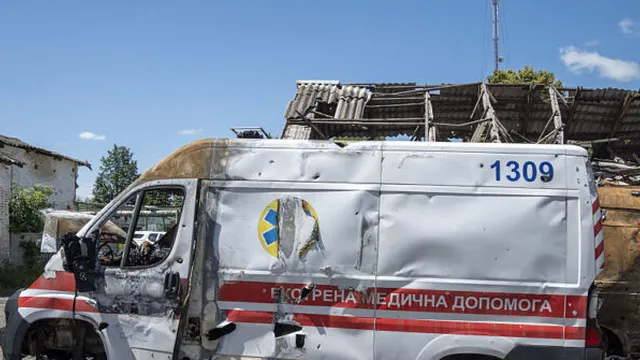
Massive Russian strikes kill nine and injure dozens in Kyiv
2025-06-24 11:27- Kyiv suffered a severe overnight missile and drone attack from Russian forces, leading to significant casualties.
- At least nine people were confirmed dead, with many others injured across various neighborhoods in the city.
- The military action exemplifies the ongoing brutality of the conflict and the dire humanitarian conditions faced by residents.
Express your sentiment!
Insights
In Ukraine, a significant escalation of violence occurred as Russian forces launched an extensive missile and drone assault on Kyiv and its surrounding regions overnight on June 23, 2025. Reports indicated that the strikes primarily targeted residential neighborhoods, hospitals, and schools, sparking widespread panic among the local populace. Residents of the affected areas witnessed the terrifying spectacle as explosives rained down from the sky, destroying both private homes and vital infrastructure. According to Kyiv Mayor Vitali Klitschko, at least nine individuals lost their lives as a result of this brutal attack, and numerous others were injured. Of those killed, several were from the Shevchenkivskyi district, known for its high population density. Eyewitness accounts described chaotic scenes of emergency responders racing to rescue those trapped under rubble, while the sound of sirens echoed across the city as fire crews worked to extinguish numerous blazes caused by the strikes. The assault marked one of the deadliest days for Kyiv since the beginning of the full-scale invasion in February 2022, with officials indicating a rise in civilian casualties. The Ukrainian air defense systems did manage to intercept a considerable number of the incoming missiles and drones, which included the usage of ballistic missiles allegedly supplied by North Korea. This situation raised serious concerns regarding regional security and the need for improved air defense capabilities. In the aftermath of the attack, both local and international leaders condemned the violence. Ukrainian President Volodymyr Zelenskyy denounced the strikes as part of a broader pattern of aggression from Moscow, emphasizing the importance of solidarity and support for Ukraine during these perilous times. Observers noted that these attacks seemed to reflect a strategy aimed at instilling fear among the civilian population, undermining morale, and causing widespread disruption across various sectors. As the situation develops, attention must be drawn to the ongoing humanitarian crisis resulting from such military actions, as civilians continue to bear the brunt of the conflict. Calls for ceasefire negotiations remain pressing but are frequently impeded by escalating hostilities and distrust between both nations. The latest assault underscores the urgent need for a re-evaluation of international responses to the conflict, as both Ukraine and its allies seek effective measures to enhance defense capabilities against ongoing aggressions.
Contexts
Since the onset of the conflict in Ukraine, NATO has played a pivotal role in bolstering the military capabilities of the Ukrainian armed forces. The alliance's commitment to Ukraine has been characterized by a multifaceted approach that includes providing military equipment, training, intelligence sharing, and strategic support. This commitment reflects NATO's recognition of Ukraine's sovereignty and territorial integrity, particularly in light of the ongoing aggression from Russia. As NATO member states have continuously responded to the evolving security environment in Eastern Europe, the support provided to Ukraine has encompassed both immediate tactical needs and long-term strategic goals. One of the key aspects of NATO's support has been the provision of modern military equipment. This has included advanced weaponry such as anti-tank missiles, artillery systems, and defensive military hardware essential for countering assaults. In the context of a rapidly changing battlefield, these resources have allowed Ukrainian forces to enhance their operational effectiveness against well-equipped opponents. Moreover, NATO has facilitated the transfer of surplus military supplies from member nations, ensuring that Ukraine can maintain its defense capabilities in the face of pressing challenges. This tangible support has been crucial in empowering Ukraine to fend off aggression and maintain national security. In addition to equipment provision, NATO has prioritized training and capacity building for Ukrainian forces. Joint training exercises, as well as specialized instruction on the use of advanced military systems, have been significant components of NATO's assistance strategy. These initiatives have not only improved the combat readiness of Ukrainian troops but have also fostered interoperability between Ukrainian and NATO forces, building resilient partnerships. Furthermore, NATO has established frameworks such as the NATO-Ukraine Annual National Programme, which outlines the reform and capability development objectives necessary for Ukraine to align its military practices with NATO standards. Lastly, the alliance's intelligence sharing mechanisms have greatly enhanced Ukraine's situational awareness on the battlefield. Access to real-time intelligence and strategic assessments has enabled Ukraine to make informed military decisions and adapt its defensive strategies effectively. As Ukraine continues to navigate the complexities of security threats, NATO's unwavering support stands as a testament to its solidarity with Ukraine and commitment to collective defense principles. The ongoing partnership illustrates a transformative shift in European security dynamics, emphasizing the importance of cooperation in maintaining stability in a region marked by geopolitical tension.